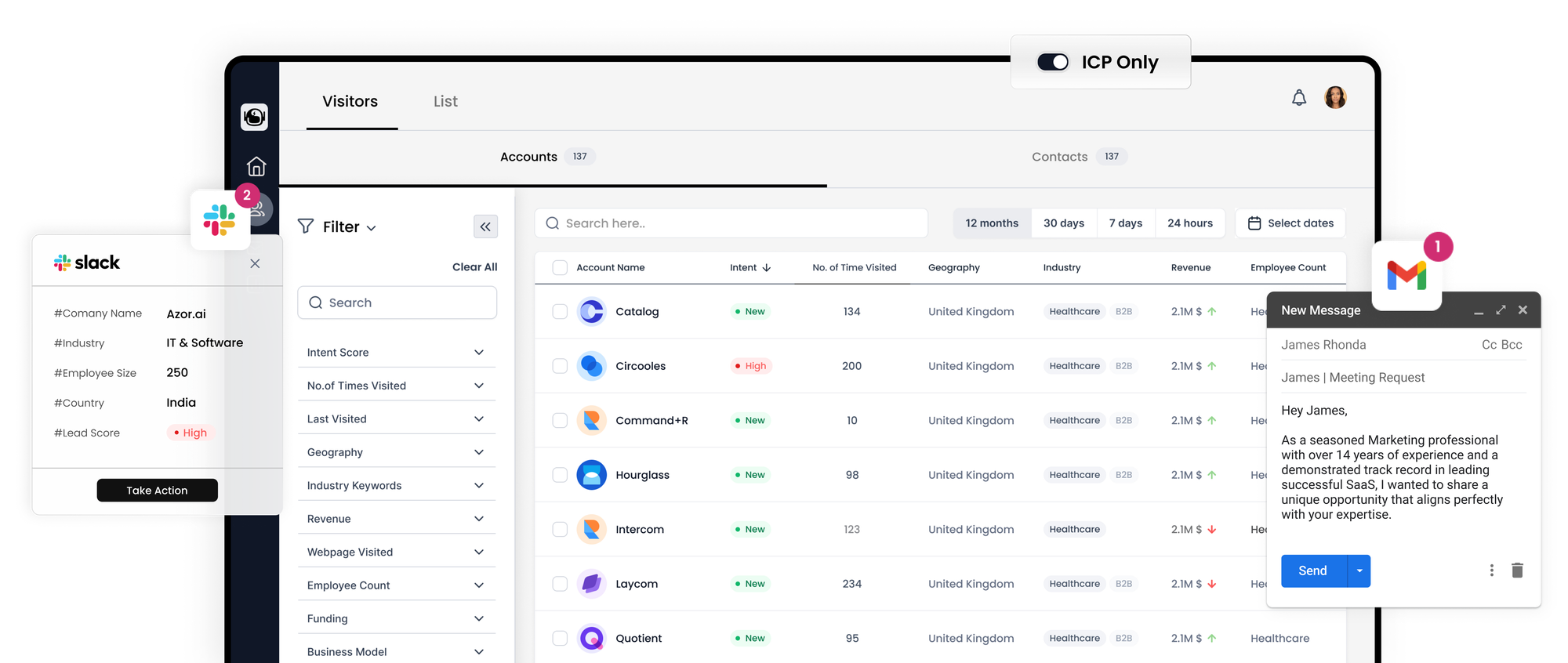Demand Generation Unveiled

Demand generation, often heard in the realm of marketing, is a multifaceted process aimed at piquing interest in a product or service and nurturing this interest into valuable, high-quality leads that have the potential to evolve into loyal customers. This strategic approach involves various tactics such as crafting compelling content to draw qualified traffic to a website, utilizing marketing automation to generate leads from existing contacts, employing customer data to design segmented campaigns, and fostering customer demand for a company's offerings. The ultimate objective is to empower organizations to boost their sales and revenue by attracting new prospects who are inclined to make purchases.

The Bounty of Demand Generation
Beyond being a mere buzzword, demand generation encapsulates a strategic framework encompassing a multitude of marketing and sales endeavors. Its purpose is to sow the seeds of awareness, stimulate interest, and, ultimately, stoke customer demand for a product or service. This holistic process melds creativity, data-driven insights, and customer-centric methodologies to fuel business expansion. Demand generation extends an array of benefits:
1. Elevated Brand Awareness
Demand-generation efforts are concentrated on cultivating awareness and visibility for a brand, thereby helping establish the company as a reputable authority within its industry.
2. Precise Lead Generation
By leveraging targeted marketing campaigns and personalized experiences, demand generation allows businesses to attract and capture high-quality leads that are more likely to convert into customers.
3. Enhanced Customer Engagement
Demand-generation strategies underscore the significance of meaningful interactions with prospects throughout their customer journey, fostering engagement and cultivating enduring relationships with the audience.
4. Augmented Trust and Credibility
Through the consistent provision of valuable content and offers, demand generation positions a company as a dependable and knowledgeable resource, earning the trust and credibility of potential customers.
5. Expanded Market Reach
Effective demand-generation techniques enable marketing teams to reach a broader audience and explore new markets, thereby unlocking avenues for business growth and expansion.
6. Heightened Conversion Rates
By nurturing and educating prospects, demand generation heightens the likelihood of converting leads into customers, maximizing conversion rates, and enhancing overall sales performance.
7. Enhanced Customer Retention
Demand generation isn't solely focused on attracting new customers; it also emphasizes nurturing existing customers, encouraging repeat business, fostering loyalty, and minimizing churn.
8. Data-Driven Insights
Demand generation leans on data analysis and tracking to gauge the success of campaigns, providing invaluable insights that can inform future marketing strategies and optimization endeavors.
9. Competitive Edge
By adeptly implementing demand-generation strategies, companies can gain a competitive advantage over rivals. This entails capturing customer attention, forging robust relationships, and maintaining prominence in a crowded market.
10. Sustainable Business Growth
Ultimately, demand generation contributes to sustained business growth by establishing a consistent pipeline of interested prospects and converting them into devoted customers, ensuring an organization's stability and profitability.
6 Phases of Demand Generation Unveiled
The journey of demand generation unfolds in a sequence of six stages, each representing a distinct phase a prospective customer traverses from initial contact to becoming a qualified, long-term patron. Crafting content and offers that align with the prospect's position in their purchasing decision-making process is paramount. While some overlap may occur between these stages, and strategies may vary depending on the customer's unique journey and the complexity of the offerings, the typical demand-generation process encompasses the following stages:
1. Awareness Stage
In this initial phase, the primary objective is to instill awareness within the target audience regarding a brand, its products, or services. Prospective customers recognize they have a problem and commence researching solutions through diverse channels, such as content marketing, social media, search engines, and referrals. The focal point lies in capturing their attention and acquainting them with the company's value proposition.
2. Interest Stage
Once prospects become aware of a company's offerings, the subsequent stage aims to kindle their curiosity and deeper engagement. Achieving this entails deploying compelling content, thought leadership pieces, educational resources, webinars, and interactive experiences. The overarching goal is to showcase the brand's expertise, construct trust, establish credibility, and concurrently keep prospects engaged and enthusiastic about discovering the best-fit solutions for their needs.
3. Consideration Stage
During this phase, potential customers embark on a thorough evaluation of a company's offerings, comparing them to alternatives as part of their due diligence. They may seek more comprehensive information, read reviews, peruse case studies, and engage with product demonstrations. Companies must furnish valuable content that addresses the customer's specific pain points and highlights the unique advantages of their products or services to aid in making an informed decision.
4. Intent Stage
At this juncture, prospects are actively contemplating a purchase. They might request price quotes, engage in sales discussions, and participate in product trials or demonstrations. The objective revolves around nurturing their intent, furnishing requisite support and information, and facilitating a confident buying decision.
5. Conversion or Decision Stage
This phase witnesses prospects taking definitive actions to become qualified leads or customers. Actions may encompass making a purchase, subscribing to a service, seeking consultation, or performing other conversions in alignment with specific business objectives. The emphasis now shifts to ensuring a seamless and effortless conversion experience, addressing concerns or hurdles, and facilitating a smooth transition from prospect to customer.
6. Retention Stage
The final leg of the customer journey, often overlooked as part of the demand generation, focuses on continuous nurturing of existing customers. This entails providing ongoing support, delivering exceptional experiences, and fostering loyalty through sustained communication and value propositions. Loyal customers evolve into strong brand advocates, frequently ushering more individuals into the demand-generation funnel's top tier through referrals.
Distinguishing Demand Generation from Lead Generation
To discern the disparities between demand generation and lead generation, it's crucial to recognize that although these terms are often used interchangeably, they harbor distinct nuances. Demand generation encompasses a broader spectrum of marketing activities that center on creating awareness, stimulating interest, and fomenting a desire for a product or service. It concentrates on kindling interest and fostering connections with potential customers even before they actively contemplate making a purchase. Conversely, lead generation specifically entails the capture and collection of information from prospects who have displayed interest in a product or service, with the aim of qualifying these leads for potential conversion into customers.
The objectives of these two approaches also diverge slightly. The primary aim of demand generation is to erect brand awareness, establish credibility, and generate demand for products or services, even if immediate conversion is not the primary focus. In contrast, lead generation's primary objective revolves around identifying and capturing individuals who have expressed interest in the company and possess the potential to be converted into customers.
Principles of Effective Demand Generation
Crafting a robust demand-generation strategy within an organization's marketing blueprint involves several essential steps. To spark demand for products and services, marketing teams should adopt the following best practices to ensure favorable outcomes and foster business expansion:
1. Establish Clear Objectives
One of the initial steps entails the development and consensus on the objectives of the demand-generation strategy. Defining specific, measurable goals serves as a yardstick for evaluating campaign success. Objectives may encompass generating new marketing-qualified leads, augmenting revenue from campaigns, or increasing the number of deals in the pipeline.
2. Precisely Define the Target Audience
To effectively tailor demand-generation endeavors, marketing teams should meticulously craft buyer personas. These personas aid in delineating the needs, pain points, motivations, and behaviors of ideal buyers.
3. Create Compelling Content
Generate high-quality, relevant content that resonates with the target audience at every juncture of the customer journey. Employ a diverse array of formats, such as blog posts, videos, infographics, e-books, webinars, and podcasts, to engage and educate prospects throughout their buyer's journey. Tailor this content to address the specific requirements of each stage, with the aim of propelling prospects further down the sales funnel.
4. Embrace a Multichannel Approach
Employ a fusion of digital marketing channels, encompassing an optimized website, search engine optimization, social media, email marketing, paid advertising, and content distribution platforms, to reach the target audience across various touchpoints. This approach ensures reaching prospects where they conduct research or frequently engage.
5. Personalize and Segment Campaigns
Harness data and marketing automation tools to infuse campaigns with personalization based on the distinct interests and preferences of the target audience. Segmentation enables teams to deliver personalized, pertinent content and experiences at each stage. If specific accounts are the target, implementing an account-based marketing strategy can prove beneficial.
6. Enhance Conversion Funnel Optimization
Perpetually refine the conversion funnel by streamlining the customer journey, reducing friction points, and enhancing the user experience. Leverage data and analytics to pinpoint bottlenecks, make data-driven enhancements, and elevate conversion rates.
7. Engage in Lead Nurturing via Email Marketing
Introduce automated email nurturing campaigns to maintain leads' engagement and guide them through the buyer's journey. Furnish valuable content and employ personalized messaging to nurture leads, fortify relationships, and ensure that the company remains foremost in the minds of prospects.
8. Measure and Analyze Outcomes
Revisit the established goals and refer to key performance indicators to gauge the effectiveness of demand-generation initiatives. Utilize analytical tools to monitor and assess pertinent metrics such as website traffic, conversion rates, engagement levels, and revenue attribution. These insights can inform campaign optimization and discern what yields results and what requires adjustment.
9. Continuously Test and Refine
Teams should conduct A/B testing on various campaign and channel elements, encompassing copy, calls to action, visuals, and offers, to ascertain resonance with the target audience. Learning from these test outcomes and iteratively improving tactics ensures that marketing teams extract the utmost value from their resources and endeavors.
10. Ensure Synchronization Between Sales and Marketing
Robust alignment between sales and marketing teams maximizes the impact of demand-generation endeavors. Regular communication concerning strategies facilitates a seamless handover of leads and permits teams to exchange valuable insights to enhance lead quality and conversion rates.
